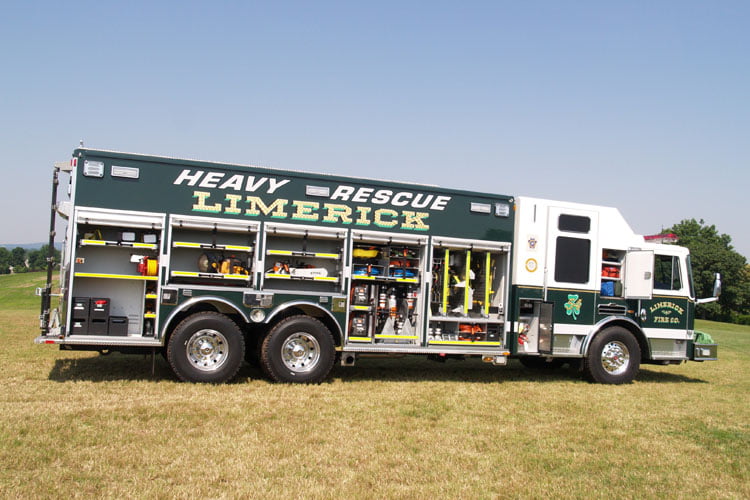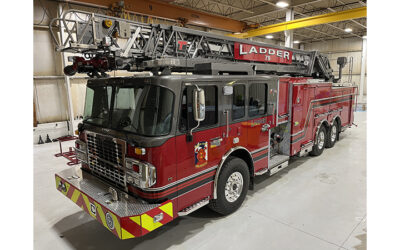By Bill Adams
Fire apparatus vendors must be forever cautious when working with prospective customers laying out equipment compartments, especially so when designing special service apparatus for use as a heavy rescue truck. They can be caught between the proverbial rock and hard place because the fine line between assisting and alienating is difficult to locate. And, inadvertently crossing it can cost the vendor a sale.
Some vendors categorize rescue truck purchasers as novices or experienced users. Novices who are upgrading from an overloaded small equipment van or squad car should be appreciative of the assistance a knowledgeable vendor can provide. On the other hand, its possible purchasers who are replacing heavy rescues may be locked into the, “That’s the way we’ve always done it,” mindset. In some scenarios, a vendor is not going to change its mind and probably shouldn’t even try.
A busy fire department may have literally thousands of runs under its belt operating a heavy rescue while a vendor may have the experience of designing scores of heavy rescues for numerous departments. The learning curve can be a two-way street, where both buyer and seller mutually benefit from each other’s experiences. A possible contentious issue that is sometimes difficult to overcome is when a vendor with volunteer firefighting experience is dealing with a career entity and conversely when a vendor with career firefighting experience is dealing with a volunteer entity. In those cases only grown-ups should be allowed on apparatus purchasing committee (APC) meetings.
- One department was adamant that compartment equipment layouts be job-specific, meaning all auto extrication equipment be stored in one; all ventilation equipment in another, and so on. The vendor pointed out the intended auto extrication equipment compartment was 44-inches wide on the interior; it had 2½-inch door jambs with two 2-inch thick vertically hinged doors allowing a mere 35-inches in between the doors to remove the equipment. The vendor mentioned another department with a similar layout regularly experienced a crew of six firefighters standing in line to access equipment because only one firefighter at a time could get between the doors.
- In their ventilation compartment, they wanted to store on the floor a 24-inch smoke ejector that was 28-inches wide. The vendor pointed out the same 35-inch available space between the doors would leave less than 4 inches each side for personnel to reach in and lift up this 100-pound piece of equipment. A floor mounted slide-out tray would not extend beyond the doors in their open position.
- Another department specified cord reels on each side of the rig but kept all their portable lights in one compartment and smoke ejectors in another. The vendor asked if they ever considered preconnecting a portable floodlight to each cord reel and mounting a smoke ejector on a shelf in the same compartment. He said it worked very well in the department he belonged to. The apparatus purchasing committee (APC) told him they were purchasing the rig for their fire department and not his.
- The same department wanted several reinforced shelves to carry their salvage covers (tarps). The vendor asked if they considered rolling their tarps and storing them in polypropylene tubes similar to—but larger in diameter—than the tubes used to store spare self-contained breathing apparatus cylinders. He said the tubes could be stacked vertically one over the other or horizontally or a combination of both. It would give them flexibility down the road to relocate them if desired. Similar holders can also be fabricated of metal in square and rectangular shapes. The vendor showed the APC photos of similar installations and even explained how rolled tarps can be easily deployed. The vendor was told not to tell the fire department how to throw and store their tarps.
- One department wanted a certain size underbody storage compartment ahead of the rear wheels. The vendor suggested writing detailed purchasing specifications describing how such compartments be weatherproofed because compartments located below the body are a magnet for moisture and road spray and could end up being dank and nasty smelling. When the vendor mentioned the compartment size wanted would affect the angles of approach and departure “between the wheels” the APC told him not to worry about it.
***
Although some vendors want to, most don’t dare tell an apparatus purchasing committee that if firefighters have to climb onto a rig to access a primary piece of equipment, the committee did a lousy job in laying out the compartments. It may be a necessity, but it is sad when an APC has to specify carrying a step ladder to reach equipment stored on a rig. Firefighters should not be placed in a position where they can get hurt removing equipment. Slide-out tool boards, shelves and pull-out and tilt-down drawers can be mansavers. Purchasers should consider working closely with more than one qualified vendor when laying out compartments. Ideas and suggestions are free for the asking. A possibility for success is writing a performance specification.
BILL ADAMS is a member of the Fire Apparatus & Emergency Equipment Editorial Advisory Board, a former fire apparatus salesman, and a past chief of the East Rochester (NY) Fire Department. He has 50 years of experience in the volunteer fire service.






